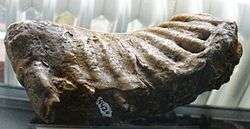Cyprus dwarf elephant
| Cyprus dwarf elephant Temporal range: Late Pleistocene–0.009 | |
|---|---|
 | |
| Tooth | |
| Extinct | |
| Scientific classification | |
| Kingdom: | Animalia |
| Phylum: | Chordata |
| Class: | Mammalia |
| Order: | Proboscidea |
| Family: | Elephantidae |
| Genus: | Palaeoloxodon |
| Species: | P. cypriotes |
| Binomial name | |
| Palaeoloxodon cypriotes Bate | |
The Cyprus dwarf elephant (Palaeoloxodon cypriotes) is an extinct species of elephant related to the living Asian elephant. It was among the only mammals on Cyprus before human arrived, and it is thought the Cyprus dwarf elephant came during the last Ice Age. They were only about 1 meter (40 inches) in height. Their small size is thought to be a response to limited resources experienced by their ancestors. Extinction for the Cyprus dwarf elephant came around 11,000 BC.
Features
Believed to be descended from the straight-tusked elephant, this much smaller species inhabited Cyprus and some other Mediterranean islands after the Messinian salinity crisis, during the Late Pleistocene. Its estimated body weight was only some 200 kilogrammes, a weight reduction of 98% from its ancestors which weighed about 10 tonnes. Their molars however were about 40% of the size of the mainland straight-tusked elephants. The factors responsible for the dwarfing of island mammals are thought to include the reduction in available food, predation and competition. The Cyprus dwarf elephant roamed the world at least until 11,000 BC.
Excavations
Remains of the first Cyprus Dwarf Elephant were discovered and documented by Dorothea Bate in 1902. She found the fossilized bones of the elephant in a cave in the Kyrenia hills of Cyprus. The species is also known under a synonym as Elephas cypriotes bate, which commemorates the paleontologist Dorothea Bate.[1]
Finds of whole or partial skeletons of this elephant are very rare. The first recorded find was by Dorothea Bate in a cave in the Kyrenia hills of Cyprus in 1902, described in a paper for the Royal Society in 1903[2] and in a later paper for Philosophical Transactions of the Royal Society of London in 1905.[3]
Human interference leading to the extinction to the Cyprus dwarf elephant has been a controversial topic over the last decade. A rising theory is that most of the elephants became deceased during the settlement of the Mediterranean islands. A claim to support this theory is that the early Greek settlers thousands of years later incorporated the dwarf elephant into their mythology calling them Cyclopses (one-eyed monsters). This is because the skull of an elephant shows a single large hole on the forehead which does resemble an eye socket - the actual eye sockets are placed quite low on the sides of the animal's head and thus easily overlooked.
See also
Notes
- ↑ Reese, David S.: Men, Saints, or Dragons? in Folklore, Vol. 87, No. 1 (1976), pp. 89–95
- ↑ Bate, D. M. A.: "Preliminary Note on the Discovery of a Pigmy Elephant in the Pleistocene of Cyprus" in Proceedings of the Royal Society of London Vol. 71 (1902–1903), pp. 498–500
- ↑ "Further Note on the Remains of Elephas cypriotes from a Cave-Deposit in Cyprus" by Dorothea M. A. Bate in Philosophical Transactions of the Royal Society of London, Series B, Containing Papers of a Biological Character, Vol. 197 (1905), pp. 347–360
References
- Davies, P., & Lister, A. M., Palaeoloxodon cypriotes, the dwarf elephant of Cyprus: size and scaling comparisons with P. falconeri (Sicily-Malta) and mainland P. antiquus in Cavarretta et al., op. cit. pp. 479–480
- Masseti, M., Did endemic dwarf elephants survive on Mediterranean islands up to protohistorical times? in Cavarretta, Gioia, Mussi & Palombo, La terra degli Elefanti, The World of Elephants (Rome, 2001) pp. 402–406
- Palombo, M. R., Endemic elephants of the Mediterranean Islands: knowledge, problems and perspectives in Cavarretta et al., op. cit.
- Simmons, Alan H. (1999). Faunal extinction in an island society: pygmy hippopotamus hunters of Cyprus. Interdisciplinary Contributions to Archaeology. Kluwer Academic/Plenum Publishers. p. 382. doi:10.1007/b109876. ISBN 978-0-306-46088-3. OCLC 41712246.